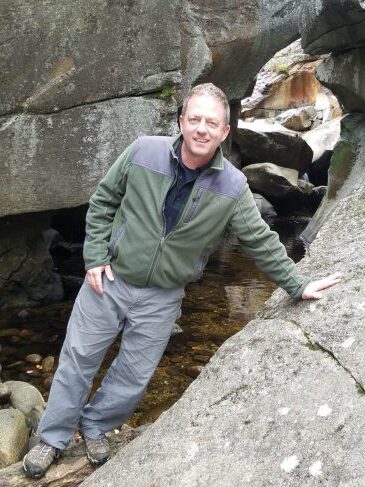Sean Smith
Sen. George J. Mitchell Center for Sustainability Solutions | MAFES | NEST
Research Focus and History | Courses | Graduate Advising
I lead the Watershed Process and Estuary Sustainability Research Group (WPES) in the School of Earth and Climate Sciences. WPES is involved in multiple research projects, including several multi-institutional projects administered by the Sen. George J. Mitchell Center for Sustainability Solutions.
IN THE NEWS….
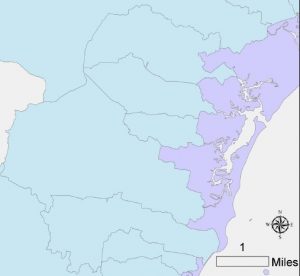 Coastal Pollution Research Grant awarded (Spring 2019) WPES affiliates have been awarded a new grant from the Maine Water Resources Research Institute to conduct research for development of decision tools related to coastal bacteria pollution. The project builds on previous research led by the Mitchell Center focused on the scientific basis for decisions governing closures of shellfish harvesting areas and beaches in response to bacteria pollution problems. The new work will focus on land-sea connections and estuaries on the Maine coast.
Coastal Pollution Research Grant awarded (Spring 2019) WPES affiliates have been awarded a new grant from the Maine Water Resources Research Institute to conduct research for development of decision tools related to coastal bacteria pollution. The project builds on previous research led by the Mitchell Center focused on the scientific basis for decisions governing closures of shellfish harvesting areas and beaches in response to bacteria pollution problems. The new work will focus on land-sea connections and estuaries on the Maine coast.
Penobscot Float Trip video published by UMaine Today magazine highlights activities during our fall semester (2016) float down the section of the Penobscot River near campus.
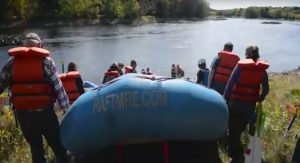
Article by Buscombe, Grams, and Smith selected as 2017 Best Technical Note by the editor of the Journal of Hydraulic Engineering.
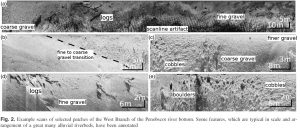
WPS research group is highlighted in UMaine Today magazine article focused on a century of research in Acadia National Park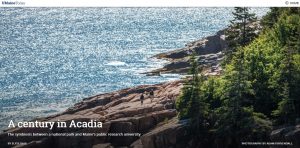
WPES affiliates are included in UMaine Today article, A Century in Acadia, The Symbiosis Between a National Park and Maine’s Public Research University. A companion article that highlights WPES research on coupled coastal watershed-estuary systems.
Maine Cooperative Snow Survey Program welcomes WPES participation (2/1/16)
Two contrasting views of stream sediment sources. McGlaughlin 2015. Environmental Connection (International Erosion Control Assn.), Vol. 9, Issue 3, pp. 8-9.
Scientists develop new tools to anticipate coastal pollution in Maine AGU Geospace Blogosphere (12/30/15)
The Future of Dams: new $6 million NSF grant. University of Maine News (8/10/15)
Student Research Spotlight: Looking for Warning Signs Beneath the Surface, Sen. George J. Mitchell Center News (2/18/15)
Publication finds upland sources contribute to sediment loads, Sen. George J. Mitchell Center News (1/29/15)
Researchers raft down Penobscot River to map changes, Aislinn Sarnacki, Bangor Daily News (6/25/14)
Poster Session Honorable Mention at Maine Sustainability and Water Conference: Van Dam, B, S. Smith, A. Reeve, B. Gerard. Hydrologic Implications of Upland Microtopography in Post-Glaciated Maine
Research Focus and History
My teaching and research focuses on watershed geomorphology with attention to processes that influence the morphology and stability of hillslopes and waterways, and that govern the flux of water, sediment and nutrients in the contemporary landscape. Topics of my past and present research include stream channel morphology and stability, surface flow patterns in headwater drainage basins, watershed sediment budgets, and modern watershed best management and rehabilitation practices. I am particularly interested in projects seeking to identify, quantify and explain changes to landscapes caused by human activities.
My work is inspired by interests in advancing the measurement, description and prediction of environmental impacts across spatial scales ranging from single hillslopes to large watersheds and time scales spanning from a single rainfall event to millennia. I have extensive experience working in the Mid-Atlantic region of North America in collaboration with partners involved with the USEPA Chesapeake Bay Program. I have a joint appointment with the Senator George J. Mitchell Center for Sustainability Solutions and affiliation with the Maine Agricultural and Forest Experiment Station (MAFES).
Interdisciplinary projects:
- The Future of Dams in New England
- Safe Beaches and Shellfish Beds – New England Sustainability Consortium
- Patterns, Processes and Practices in the Headwaters of Central and Coastal Maine
- River habitat analysis for sturgeon habitat recovery (Penobscot River)
- Safeguarding a Vulnerable Watershed (Sebago Lake)
These projects involve faculty, post-doctoral researchers, graduate students, and undergraduate research assistants that comprise the School of Earth and Climate Science’s Watershed Process and Sustainability Research Group working in collaboration with multiple colleagues, government agencies, and project stakeholders in Maine and beyond.
Courses
ERS 200 – Earth Systems
ERS 350 – Freshwater Flows
ERS 588 – Advanced Freshwater Flows
ERS 361 – Principles of Geomorphology
ERS 461 – Fluvial Processes in Geomorphology
ERS 602 – Critical Zone and Watershed Sustainability Research
Graduate Advising
Advisor
Current:
Bea Van Dam – Ph.D. Student, Land-sea connections driving coastal pollution vulnerability
Andrew Newcomb – M.S. Student, Future of dams in New England
Ian Nesbit – M.S. Student, Maine lake sedimentation
Hannah Horecka – M.S. Student, Coastal pollution dynamics
Graduated:
Brett Gerard – Ph.D., 2018, Channel bed dynamics in a coupled human-climate-postglacial system
Publications, Reports, and Professional Activities
Recent Publications
- Johnston, C., G.B. Zydlewski, S. Smith, J. Zydlewski, and M.T. Kinnison. 2019. River reach restored by dam removal offers suitable spawning habitat for endangered shortnose sturgeon. Transactions of the American Fisheries Society, Vol. 148, Issue 1, pp. 163-175; DOI: 10.1002/tafs.10126
- Roy, S.G., E. Uchidab, S.P. de Souzac, B. Blachly, E. Fox, K. Gardner, A.J. Gold, J. Jansujwicz, S. Klein, B. McGreavy, W. Moc, S.M.C. Smith, E. Vogleri, K. Wilson, J. Zydlewskik, and D. Hart. 2018. Damming decisions: a multi-scale approach to balance trade-offs among dam infrastructure, river restoration, and cost. Proceedings of the National Academy of Sciences Nov 2018, Vol. 115, No. 47, pp. 12069-12074; DOI:10.1073/pnas.1807437115
- Roy, S., G. Tucker, P. Koons, S. Smith, and P. Upton. 2016. A fault runs through it: modeling the influence of rock strength and grain-size distribution in a fault-damaged landscape. Journal of Geophysical Research, Vol. 121, I. 10, pp. 1911–1930, doi
- Buscombe, D., P.E. Grams, S.M.C. Smith. 2015. Automated riverbed sediment classification using low cost side-scan sonar. Journal of Hydraulic Engineering, doi: 10.1061/(ASCE)HY.1943-7900.0001079 , 06015019.
- Filoso, S., S.M.C. Smith, M.R. Williams, and M.A. Palmer. 2015. The Efficacy of Constructed Stream–Wetland Complexes at Reducing the Flux of Suspended Solids to Chesapeake Bay. Environmental Science and Technology, Vol. 49, No. 15, pp. 8986–8994. doi: 10.1021/acs.est.5b00063
- Buscombe, D., P.E. Grams, T.S. Melis, and S.M.C. Smith. 2015. Large river bed sediment characterization with low-cost sidescan sonar: case studies from two settings in the Colorado (Arizona) and Penobscot (Maine) Rivers. SEDHYD 2015, 3rd Joint Federal Interagency Conference (10th Federal Interagency Sedimentation Conference and 5th Federal Interagency Hydrologic Modeling Conference.
- Smith, S.M.C. and P.R. Wilcock. 2015. Upland Sediment Supply and its Relation to Watershed Sediment Delivery in the Contemporary Mid-Atlantic Piedmont (U.S.A.), Geomorphology, Vol. 232, pp. 33-46, http://dx.doi.org/10.1016/j.geomorph.2014.12.036 http://www.sciencedirect.com/science/article/pii/S0169555X14006400
- Parr, T.B., C.S. Cronin, T. Ohno, S.E.G. Findlay, S.M.C. Smith, and K.S. Simon. 2015. Urbanization changes the composition and bioavailability of dissolved organic matter in headwater streams. Limnology and Oceanography, Vol. 60, Issue 3, pp. 885-900, doi: 10.1002/lno.10060
Education Publications
- Smith, S., L. Gutierrez, and A. Gagnon. 2000. Maryland Streams – Take a Closer Look. Watershed Restoration Division, Maryland Department of Natural Resources. Reprinted 2003, 2005, 2009.
Recent Presentations
- Skalak, K., J.E. Pizzuto, D.L. Karwan, S. Mahan, A. Benthem, E.W. Boyer, A. Kettner, R.K. LeBivic, A.J. Miller, G.B. Noe, and S.M.C. Smith. 2018. Temporal and spatial scales of sediment transport processes for watershed management. Fall Meeting, American Geophysical Union. Washington, D.C.
- Gerard, B. and S.M.C. Smith. 2018. Stream dynamics in headwaters of postglacial watershed systems. Maine Sustainability and Water Conference, Augusta, Maine.
- McGreavy, B., S. Randall, T. Quiring, S. Smith, S. Roy, B. Gerard, and C. Hathaway. 2017. Communicating coastal resilience: Interdisciplinary research partnerships to support shellfish management and protect public health. Conference on Communication and Environment, University of Leicester (UK).
- Smith, S.M.C. 2017. INVITED – What is the importance of legacy sediment relative to other sediment sources in the Chesapeake Bay watershed? Chesapeake Bay Program, Science and Technical Advisory Committee workshop on legacy sediment. Annapolis, Maryland.
- Smith, S.M.C. 2017. INVITED – Examining and communicating coastal pollution problems along the coast of Maine. Northeast Shellfish Sanitation Annual Meeting. Freeport, Maine.
- Roy, S., B. Gerard, S. Smith, and B. McGreavy. 2017. A runoff based vulnerability analysis to examine the dynamics of bacteria pollution events in the Gulf of Maine. Maine Sustainability and Water Conference. Augusta, Maine.
- Smith, S. 2017. The ups and downs of simulation watershed processes in the Maine terrain. Maine Association of Professional Soil Scientists – Annual Meeting. Orono, Maine.
- Smith, S.M.C. 2016. INVITED – Downeast drainage: sources, delivery and residence time of runoff and pollutants along the Gulf of Maine coast. Geological Society of Maine, Fall Meeting. November 21, 2016.
- Smith, S.M.C. 2016. INVITED – Mentoring through measurement, monitoring and modeling the Penobscot River. Penobscot Watershed Conference: Sharing our heritage, challenges and future. Lincolville, Maine. April 2016.
Recent Posters
- Van Dam, B.E., S.M.C. Smith, K. Beard, and S.G. Roy. 2018. Upland Micro-topography and implications to surface water detention in Maine. Fall Meeting, American Geophysical Union. Washington, D.C.
- Nesbit, I.M., S.W. Campbell, S.A. Arcone, S.M.C. Smith, B.G. Koffman. 2018. Sedimentary architecture and accumulation rates of multiple lakes in New England, USA. Fall Meeting, American Geophysical Union. Washington, D.C.
- Roy, S.G., S.M.C. Smith, B. McGreavy, B. Gerard, B.E. Van Dam, and J.L. Ross. 2018. Resilient coastal communities: using interdisciplinary research and stakeholder engagement to face coastal pollution challenges in northern New England. Fall Meeting, American Geophysical Union. Washington, D.C.
- Neptune, S., S. Roy, and S.M.C. Smith. 2018. Flooded corridors and the inundation of a nation. Maine Sustainability and Water Conference, Augusta, Maine.
- Richmond, N., P. Koons, L. Ross, S. Smith, S. Roy, G. Zydlewski, and J. Zydlewski. 2018. Post-dam removal river hydraulics and the influence of derelict industrial logging infrastructure on modern aquatic habitat conditions. Maine Sustainability and Water Conference, Augusta, Maine

